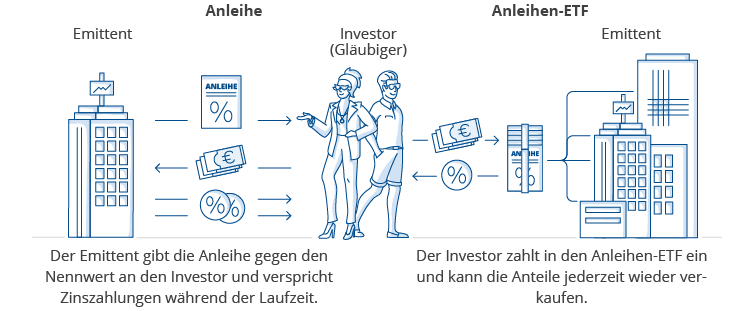ETFs are on everyone's lips - but do they also exist for bonds? How useful are such bond ETFs?
Without question, the asset class of bonds in a portfolio plays an important role. However, since many government bonds and also some corporate bonds with good credit ratings are yielding negative or only minimally positive returns in the current low-interest environment, it is questionable whether bond ETFs make sense.
In addition, many corporate bonds can only be traded with a minimum amount of 100,000 euros. They are therefore not suitable for a broad diversification of a private investor's portfolio. However, even with small portfolios, there is an opportunity to make broadly diversified investments in bonds.

Exchange Traded Funds (ETFs) also exist for bonds. The broad diversification is achieved using Exchange Traded Funds on bond indices, also known as bond ETFs. ETFs are mostly passive investment funds that can be traded on the stock exchange. Passive because the bond ETFs replicate an index and do without active fund management. This lowers the costs for the investor. There are hundreds of bond ETFs available in the market. Therefore, it makes sense to consider in advance which form of bonds should be represented by the index. But here you are spoiled for choice.
A bond index is a composite of several bonds of a specific region, risk category or the same type of bond
Examples include:
- Government Bond Index
- Pawnbond Index
- Convertible Bond Index
- Corporate Bond Index
- High Yield Corporate Bonds Index
Well-known indices in the bond segment are, for example, the following three bond indices:
- FTSE MTS Eurozone Government Broad Investment Grade
- Bloomberg Euro Corporate Bond Index
- iBoxx MSCI ESG USD FRN Investment Grade Corporates
READ MORE IN OUR FREE BROCHURE
The Geneve Invest Group has been successfully active in the field of asset management for many years and offers you valuable insights into the capital market. Find out why we have had corporate bonds in our portfolio for more than 20 years and why nothing will change in the future.
Physical or synthetic index replication?
A bond ETF tracks the performance of a bond index. This is done either by physical or synthetic replication. In the case of the latter, the index is replicated via an exchange transaction (“ Total Return Swap ”). The ETF enters into a contract with a financial institution that agrees to pay the ETF the index return in exchange for a fee. Physical replication means that the ETF buys the stocks in the index at the same ratio as they are in the index. Investors who now pay into the ETF are actually investing in the stocks that are in the index. If the index adjusts the selection or weighting of its stocks, the ETF automatically adjusts each time.
Cost-effectiveness of ETFs
The ETF aims to return-track this index with maximum cost-efficiency. This happens in particular because the replication is automated and there is no fund management behind it that controls it manually. This is different than, for example, bond funds, which also focus on bonds but are actively managed. The average total cost of bond funds is 0.90% annually. The cost of a bond ETF is just 0.48%, about half that.

Price gains & risk rating of a bond ETF
The return on the bond ETF comes from the interest on the bonds and potential price gains on the bonds. An average return per year in percent is therefore difficult to define. You don't get interest on bond ETFs like investing directly in bonds. All profits flow collectively into the fund volume and are usually reinvested ("accumulating ETF"). The profits of the bond ETFs then arise for the investor through an increase in the price when selling. In general, an ETF always reflects the risk of the individual stocks (the underlyings) in the index. The risk of a bond ETF can be classified as manageable, since bonds with a good credit rating are not among the riskier investments such as stocks. However, they still have a higher risk than, for example, the classic forms of savings such as overnight money and fixed-term deposits. Basically, the longer the maturities of the bonds held in the ETF, the greater the fluctuation intensity of the ETF price.
Now is the ideal time to invest in bonds. Corporate bonds currently offer yields of over 7% pa
Arrange a callback from one of our experts now. We advise you free of charge and without obligation and find the best corporate bonds for you.
For investors with €100,000 or more
Free advice & callback service
Assessment by Genève Invest – For whom is a bond ETF useful?
In larger portfolios it makes more sense to represent the bond component with direct investments. Only these generate a calculable cash flow.
Bond ETFs are a tried and tested means of covering the bond side efficiently and cost-effectively, even in smaller portfolios, and thus incorporating security components into the portfolio. According to Genève Invest's many years of experience, however, it makes more sense in larger portfolios to present the bond side with individual direct investments in bonds, since only these pay predictable and calculable interest coupons and generate a high cash flow with the fixed maturities, which is particularly popular with retirees. to generate regular additional income. Accordingly, we cannot claim that a bond ETF makes sense, since bond ETFs cannot adequately fulfill the functions just mentioned.

